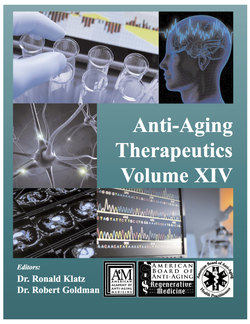Читать книгу Anti-Aging Therapeutics Volume XIV - A4M American Academy - Страница 75
FREE RADICAL SCAVENGERS
ОглавлениеRoy Walford, through his research as a biologist, stated that diabetics age 15 to 20 years faster than their chronological age. Diabetics have a decrease in total SOD activity in most organs. For example, the kidneys have 72 percent less. This oxidative injury can account for higher rate of kidney failure. The lifespan of humans is directly related to the level of SOD and glutathione peroxidase protection against the deleterious effects of reactive oxygen species (ROS). Improving diet, exercise and nutritional supplementation often leads to immediate and significant improvements in the appearance of the blood.
There are less lipids and glucose, cleaner arteries, a significant decrease in free radical damage, lipid peroxidase, blood pressure, reduced body fat and increased energy. This is clear, direct feedback coming from one’s own body. Changes in the blood can pave the way to long term success and healthy changes in lifestyle. The medical literature supports the use of microscopy, lipid, glucose, and insulin testing to identify the best dietary therapy, exercise and supplements for control of diabetes, heart disease and stroke prevention. The clinical protocol is supportive of healthy, clean, youthful arteries.
Many neurological and psychiatric diseases are improved with glutathione because its serves as an antioxidant for the brain where more oxidative by products are generated per gram of tissue than any other organ. Glutathione is made up of three amino acids (glutamic acid, cysteine, glycine) generated inside the cells from asparagus and watermelon. L-Citrulline (found inside the rind of watermelon) is excreted into the circulation and reabsorbed in the kidney and converted into L-arginine. Other pathways work together to release nitric oxide gas into the arterial wall. Cytidine-5-diphosphate choline is essential for synthesis of phospholipids in brain tissue assisting in neuron communication.
As we age, the arteries produce superoxide, which is a form of reactive oxygen toxic species (ROTS). Other keys to fighting inflammation lie in an anti-oxidant power of nitric oxide. The ability to produce nitric oxide from L-arginine is lost in senior citizens. We can replace basic dietary nitrates from specific plants including kale and beets to increase nitrogenous base. Oxidation of nitric oxide (NO) and salivary nitrate by bacteria in the mouth and GI tract provides additional benefits to create more free radical scavengers. Low calorie vegetables enhance the body’s ability to neutralize oxidative stress because of less oxidative by-products. Low fat intake reduces inflammation and oxidative stress. Avoidance of foods such as gluten or dairy whey reduces inflammatory IgG-antigen complexes. The daily availability of nitric oxide will vasodilate the arteries letting more oxygen to all the cells and tissues of the body. High nitric oxide and oxygen levels are protective against malignant cancer cells.
